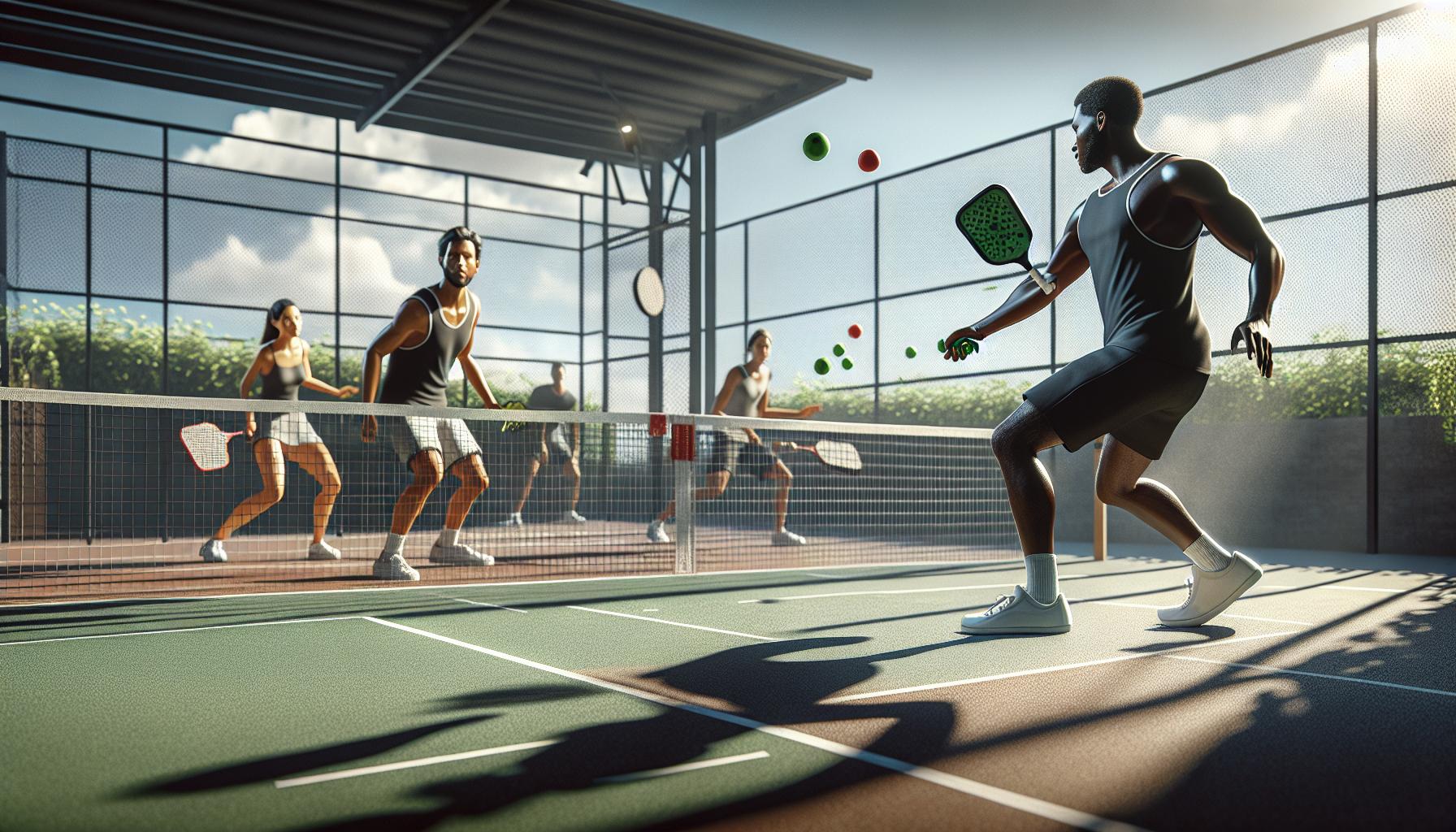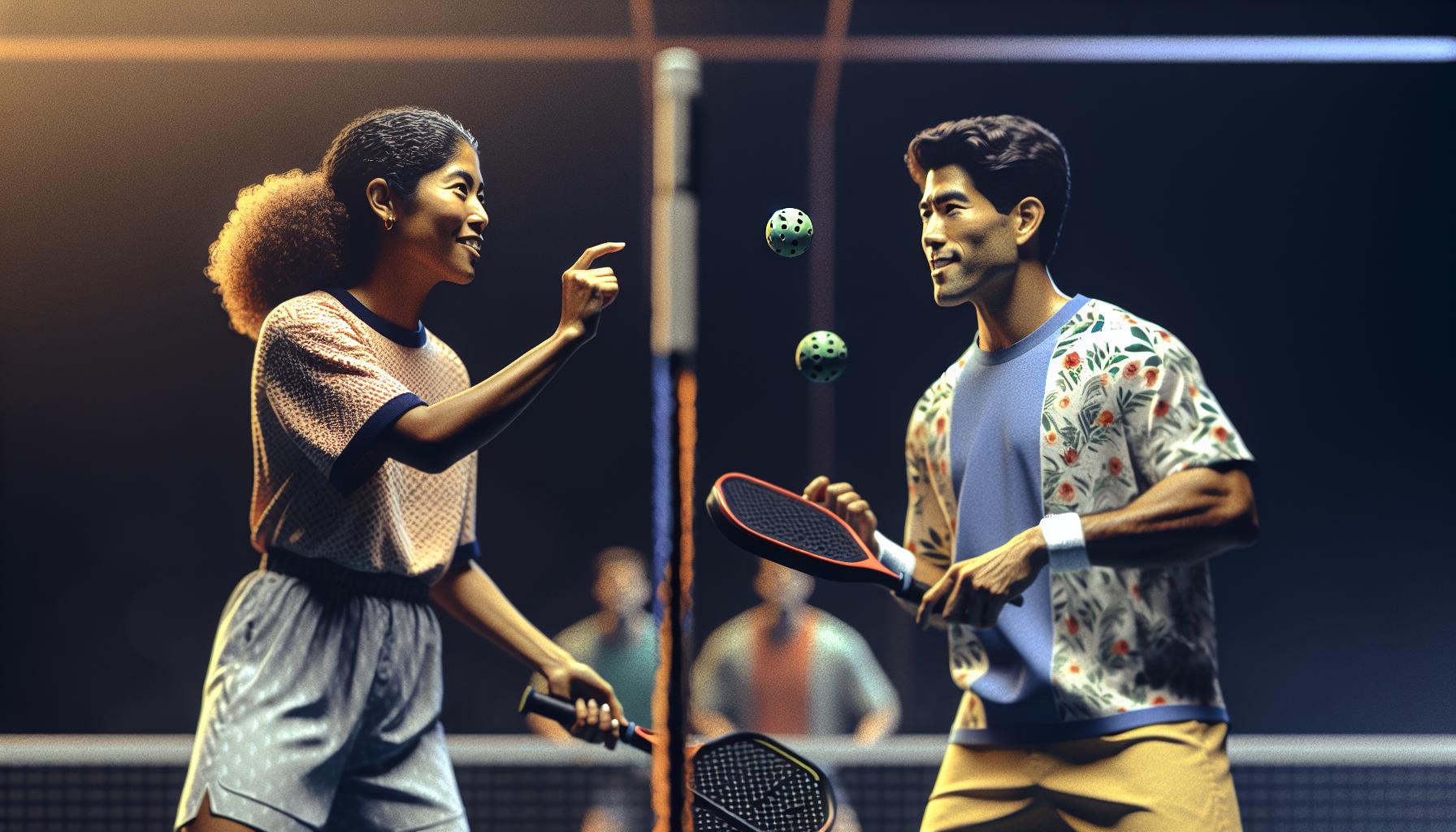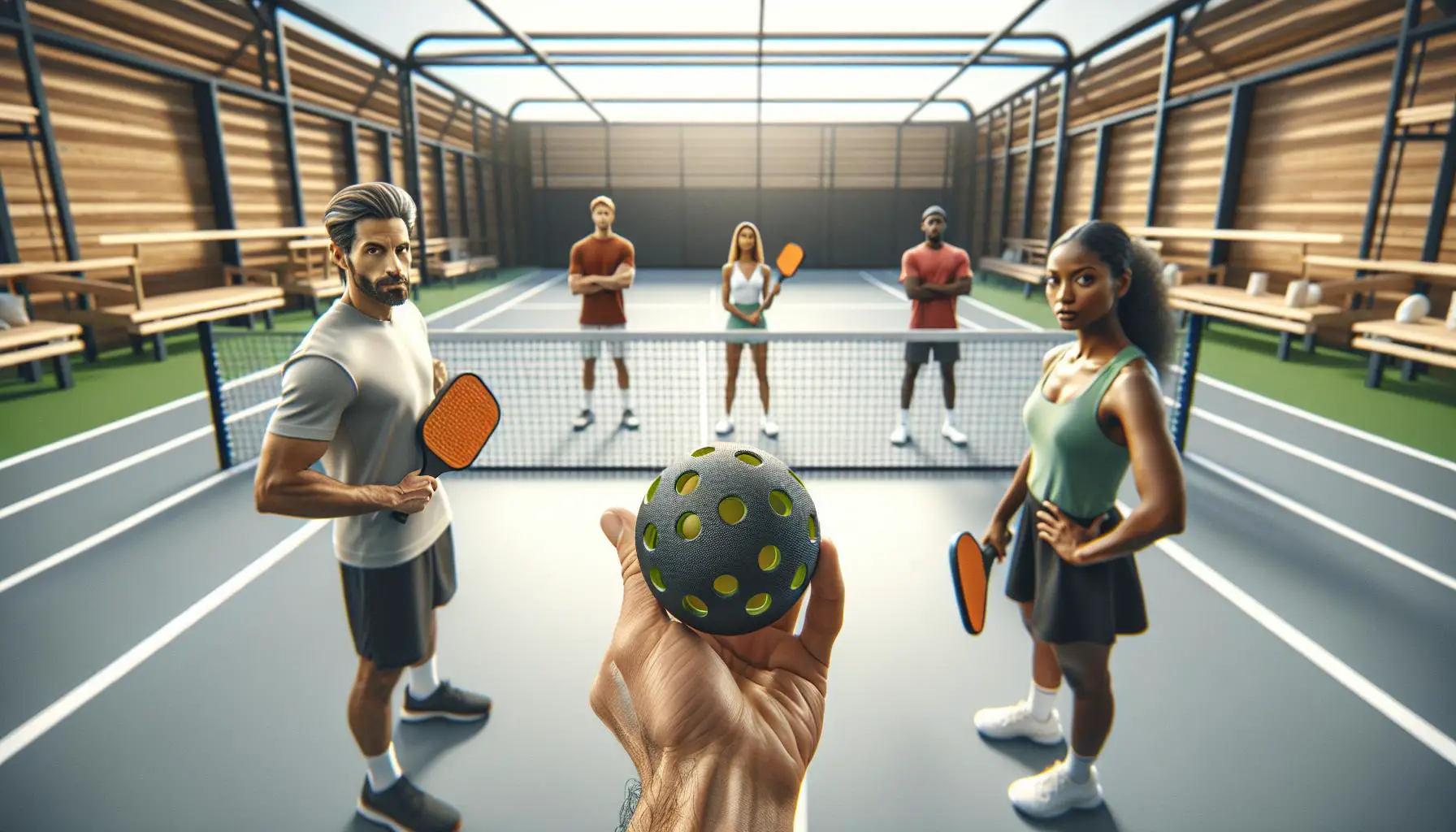Pickleball’s soaring popularity has brought its unique rules and strategies into the spotlight, with the two-bounce rule standing out as a game-changer. This rule isn’t just a quirky addition; it’s a core aspect that shapes the flow and strategy of the game, making pickleball accessible and challenging for players of all levels.
Understanding the two-bounce rule is crucial for anyone looking to step up their pickleball game or simply to grasp why matches unfold the way they do. It’s more than just a rule; it’s a doorway to mastering the sport, encouraging players to think on their feet and strategize with every swing. Let’s dive into the details and uncover the significance of this pivotal rule in pickleball.
Origins of the Two-Bounce Rule
The history of pickleball and the inception of the two-bounce rule are intertwined, tracing back to the game’s origins in 1965. Developed on Bainbridge Island, Washington, by three friends—Joel Pritchard, Bill Bell, and Barney McCallum—pickleball was initially a backyard family game. It was an improvised effort to entertain their children during the summer, combining elements from badminton, tennis, and ping-pong. The aim was to create a game that all family members could enjoy, regardless of age or athletic ability.
As pickleball evolved, the necessity for a unique set of rules became apparent to ensure it remained both challenging and accessible. One of the pivotal moments in its development was the introduction of the two-bounce rule, which mandates that the ball must bounce once on each side of the net before volleys are allowed. This rule wasn’t part of the original gameplay but was incorporated to slow down the pace of the game, making it more strategic and enjoyable for players of varying skill levels.
Purpose Behind the Rule
The primary motivation behind the two-bounce rule was to level the playing field, giving players of all ages and abilities the chance to compete more fairly and enjoyably. This rule diminishes the advantage of power and speed, emphasizing strategy, positioning, and skill instead. It encourages players to think ahead, anticipate opponents’ moves, and develop more thoughtful strategies.
By requiring the ball to bounce twice, the game effectively reduces the dominance of the “kitchen” or the non-volley zone, promoting longer rallies and more dynamic exchanges. This adjustment helped bridge the gap between less experienced players and veterans, making pickleball more engaging for everyone involved.
Adoption and Impact
The adoption of the two-bounce rule had a profound impact on how pickleball was played and perceived. It transformed the game from a backyard pastime into a sport with a unique identity, distinct from the racquet sports it was derived from. This rule has not only been fundamental in shaping the strategic depth of pickleball but has also played a crucial role in its burgeoning popularity. Today, the two-bounce rule is a cornerstone of the game, ingrained in the official rules governed by the USA Pickleball Association (USAPA).
How the Rule Impacts Gameplay

The two-bounce rule in pickleball significantly alters the flow of the game, creating a more strategic and inclusive environment for players of all ages and skill levels. By requiring the ball to bounce once on each side of the net before volleys are allowed, the game slows down momentarily, allowing players to position themselves and anticipate their opponents’ next moves. This shift from a power-driven to a strategy-driven game encourages longer rallies and more dynamic exchanges between players.
Players must develop a keen understanding of positioning and shot selection, as the rule offers a brief respite to set up strategic plays. This aspect of pickleball underlines the importance of mental acuity alongside physical skill, making the game not only a test of strength and agility but also of intellect and foresight.
Moreover, the two-bounce rule levels the playing field for participants of varying physical abilities. Since the game is less about overpowering one’s opponent and more about outsmarting them, players who might not have the speed or power of their younger or more athletic counterparts can still compete effectively. This inclusivity broadens the appeal of pickleball, allowing families, friends, and communities to participate together regardless of individual physical prowess.
The introduction of the two-bounce rule has also led to the evolution of specific strategies and playing styles within pickleball. For instance, players often use the time after the serve and return to advance towards the net, setting themselves up in a favorable position for when the ball is in open play. This transition to the net is crucial as controlling the net area can often dictate the pace and direction of the game.
Additionally, the rule fosters a deeper appreciation for the sport’s strategic complexities. Players must constantly adapt their strategies based on the evolving dynamics of each point. The necessity to think several moves ahead adds a layer of psychological warfare, with players attempting to outwit each other while adhering to the constraints of the two-bounce rule.
Lastly, the impact of the two-bounce rule extends beyond player strategies to influence the design and development of pickleball equipment. Manufacturers have tailored paddles, balls, and other gear to accommodate the unique demands of the sport, ensuring that equipment enhances the strategic elements introduced by the rule. This symbiotic relationship between the rules of the game and the equipment used ensures that pickleball continues to evolve as a sport that is accessible, challenging, and enjoyable for all.
Exceptions to the Two-Bounce Rule

While the two-bounce rule is a fundamental aspect of the game, fostering a unique blend of strategy, patience, and skill in pickleball, there are specific scenarios where exceptions apply. Understanding these exceptions is crucial for players who wish to master the game fully and appreciate its intricacies.
Firstly, during a serve, the ball must bounce once on the receiver’s side, but the server isn’t bound by the two-bounce rule immediately after this. It means after the ball has bounced once in the correct service court, the game transitions into the regular phase where the ball can be volleyed (hit without bouncing) once it crosses the net and enters the non-volley zone.
Another notable exception revolves around faults. If a player hits the ball before it bounces twice inadvertently, crossing the non-volley line on the serve or the return of serve, it’s considered a fault, and the point goes to the opponent. This scenario is crucial in matches where quick reflexes might tempt players to volley too early.
Furthermore, the rule slightly alters when it comes to the kitchen or the non-volley zone. Players are allowed to step into the kitchen after the ball has bounced once. However, they cannot volley the ball while standing in the kitchen. This is designed to prevent players from dominating the play at the net and encourages a more back-and-forth style of gameplay.
In doubles play, a specific exception applies to the two-bounce rule. Both members of the serving team must let the ball bounce once before hitting it, but only the receiver is required to let the serve bounce on their side. This asymmetry in the rule’s application adds an additional layer of strategy and communication for doubles teams.
Lastly, in tournament play or official matches, certain conditions such as wind or an unanticipated obstacle on the court might lead to officials allowing a replay of the point, even if the two-bounce rule was not correctly followed. This exception is rare and at the discretion of the official or referee, emphasizing the rule’s importance in standard gameplay.
| Exception Scenario | Details |
|---|---|
| Serve | Server exempt from two-bounce on serve; Receiver must let it bounce once. |
| Faults | Hitting the ball before it bounces twice across the net results in a fault. |
| Non-volley zone (Kitchen) |
Strategies to Utilize the Rule Effectively

In the game of pickleball, mastering the two-bounce rule is not just about understanding its mechanics but also about leveraging it to elevate one’s game strategically. Players can employ various tactics to turn this rule to their advantage, making each match not only a test of skill but also of strategic acumen.
Firstly, effective communication in doubles play becomes paramount. Teams should always know who is going to handle the first return after the ball has bounced once. This requires swift decision-making and clear, concise communication. Misunderstandings can lead to missed opportunities or unforced errors, so practicing pre-determined signals or quick verbal cues can make a significant difference.
Another tactic involves controlling the pace of the game. Players can use the two-bounce rule to slow down the game, allowing them to reset their positions and strategy. By carefully placing their returns to ensure the ball bounces once, players can create more time for themselves to get to the non-volley zone line, also known as the kitchen. This area is crucial for offensive play, and getting there first often provides a tactical advantage.
The element of surprise should not be underestimated. Skilled players can manipulate the opponent’s expectations by playing unexpected shots that still adhere to the two-bounce rule. For example, a soft drop shot just over the net after the ball has bounced once can catch an opponent off guard, especially if they were anticipating a hard drive. This can force the opponent to rush their shot, leading to errors or less strategically placed returns.
Positioning plays a critical role in utilizing the two-bounce rule to one’s advantage. Players should aim to position themselves in such a way that they can easily cover the court after the first bounce, maintaining a stance that allows for quick movement in any direction. Good positioning ensures that players are not only ready to comply with the two-bounce rule but also positioned to execute effective shots in response to their opponent’s play.
Lastly, understanding the psychological aspect of the game can help players use the two-bounce rule more effectively. Opponents who are less familiar with the ins and outs of the rule may become frustrated or confused, leading to mistakes. Experienced players can exploit this by playing in a way that legally pushes the boundaries of the rule, thereby increasing the psychological pressure on their opponents.
Mastering the Two-Bounce Rule

Enhancing one’s pickleball game significantly hinges on mastering the two-bounce rule. This rule, seemingly simple at its core, opens up a realm of strategic depth and tactical finesse. Players who understand and leverage this rule often find themselves at an advantage, controlling the pace and flow of the game with confidence.
Communication and Coordination stand at the forefront of mastering this rule, especially in doubles play. A well-coordinated team can use the two-bounce rule to set up and execute plays that leave opponents scrambling. Effective communication ensures that both players are on the same page, reducing the chances of missed opportunities or unforced errors.
Strategic positioning also plays a pivotal role. Players must position themselves optimally after the serve to anticipate and react to the ball after it bounces twice. The goal here is to take control of the net as quickly as possible. Dominating the net area allows players to dictate the game’s pace, making it harder for the opponents to find openings.
Another crucial aspect is Pace Control. Players can use the two-bounce rule to slow down or speed up the game. Slow ball exchanges give players more time to position themselves strategically, while fast exchanges can catch opponents off guard. The key is to vary the pace, keeping opponents guessing and off balance.
Surprise tactics within the framework of the two-bounce rule can also be particularly effective. For instance, players might feign a powerful return only to gently drop the ball over the net. Such unpredictability can frustrate opponents and lead to easy points.
Beyond the physical and tactical strategies, there’s a psychological component to mastering the two-bounce rule. Players who can maintain composure and patience, especially under pressure, tend to use the rule more effectively. They’re able to wait for the perfect moment to strike or force an error from their opponents, turning the rule into a psychological weapon.
Lastly, constant practice cannot be overstated. Regular gameplay and scenario-based practice allow players to internalize the two-bounce rule, making the application of the associated strategies second nature. Whether it’s working on precise ball control, developing quicker reflexes, or honing strategic thinking, consistent practice is the foundation upon which mastery of the rule is built.
Conclusion
Mastering the two-bounce rule isn’t just about knowing when to let the ball bounce; it’s about weaving this knowledge into your overall game strategy. The article has shown that with the right combination of communication, positioning, and pace, players can elevate their game significantly. It’s clear that the rule isn’t just a restriction but an opportunity to outsmart and outplay opponents. Remember, practice makes perfect, and incorporating these strategies into your game will not only make you a formidable player but also bring a deeper appreciation for the nuances of pickleball. So grab your paddle, hit the court, and let the games begin!














0 Comments